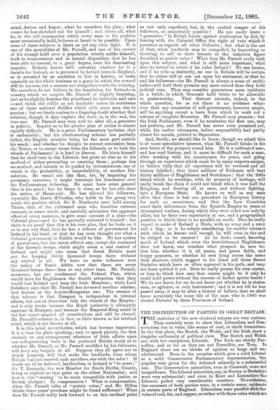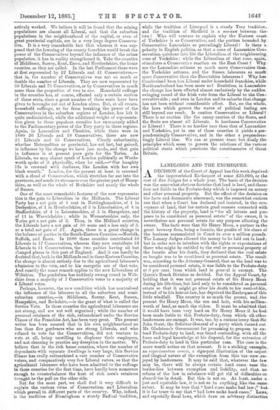THE DISTRIBUTION OF PARTIES IN GREATBRITAIN.
THE statistics of the new electoral returns are very curious. They certainly seem to show that Liberalism and Con- servatism run in veins, like seams of coal, or chalk formations. In the first place, the Scotch, the Welsh, and the Irish show a singular uniformity of political view. The Scotch and Welsh are, with few exceptions, Liberals. The Irish are chiefly Par- nellite, and so far as they are not Parnellite, are Tory. In England there are no blocks of opinion so large and"un- adulterated. Even in the counties which give a solid Liberal or a solid Conservative Parliamentary representation, the popular vote given for the defeated minority is a substantial one. The Conservative minorities, even in Cornwall, were not insignificant. The Liberal minorities, say, in 'Surrey or-Berkshire were very substantial; and even in Kent and Lancashire the Liberals polled very considerable numbers. 'Nevertheless, the successes of 'both parties were, in a certain sense, epidenxic in certain parts of 'England. Liberalism runs parallelwIthlhe veins of coal, tin, and copper, or rather with those veins which are
actively worked. We believe it will be found that the mining populations are almost all Liberal, and that the suburban populations in the neighbourhood of the capital, or even of great provincial capitals, are in a very large degree Conserva- tive. It is a very remarkable fact that whereas it was sup- posed that the lowering of the county franchise would break the power of the Conservatives beyond the influence of the urban population, it has in reality strengthened it. Take the counties of Middlesex, Surrey, Kent, Essex, and Hertfordshire, the home counties, as they are called. In the last Parliament these were at first represented by 22 Liberals and 41 Conservatives,— that is, the number of Conservatives was not so much as double the number of Liberals. They are now represented by 30 Liberals and 73 Conservatives,or by Conservatives in much more than the proportion of two to one. Household suffrage in the counties has, of course, affected only a certain section of these seats, since a great number of these seats have been given to boroughs cut out of London alone. But, at all events, household suffrage, so far from breaking the power of the Conservatives in the suburban regions of London, has left it quite undiminished, while the additional weight of representa- tion given to these populous counties has enormously added to the Parliamentary power of the Tory party in these regions. Again, in Lancashire and Cheshire, while there were in 1880 26 Liberals and 18 Conservatives, there are now 24 Liberals and 45 Conservatives. Clearly suburbanity, whether Metropolitan or provincial, has not lost, but gained, in influence by the change we have just made, and that gain in influence is at present pure gain for the Tories. As Liberals, we may almost speak of London politically as Words- worth spoke of it physically, when he said,—" Our haughty life is crowned with darkness, like London with her own black wreath." London, for the present at least, is crowned with a cloud of Conservatism, which stretches far out into the provinces, and sends its streamers over the greater part of Hamp- shire, as well as the whole of Berkshire and nearly the whole of Sussex.
One of the most remarkable features of the new representa- tion is the gain to Liberalism in the Midlands. The Liberal Party has a net gain of 1 seat in Nottinghamshire, of 1 in Derbyshire, of 1 in Herefordshire, of 3 in Lincolnshire, of 4 in Staffordshire, of 4 in Leicestershire, of 5 in Shropshire, and of 11 in Warwickshire ; while in Worcestershire only, the Tories get- a net gain of 3. Thus, in the Midland counties, the Liberals have a net gain of 30 seats and a loss only of 3, or a total net gain of 27. Again, there is a great change in the balance of parties in the South-Eastern Counties,—Norfolk, Suffolk, and Essex. In 1880 these counties contributed 10 Liberals to 17 Conservatives, whereas they now contribute 18 Liberals to 11 Conservatives, the two parties having all but changed places in this part of England. And it can hardly be doubted that, both in the Midlands and in these Eastern Counties, the change is almost entirely due to the agricultural labourer's admission to the vote, and to his energetic use of that vote. And exactly the same remark applies to the new Liberalism of Wiltshire. The pendulum has suddenly swung round in Wilt- shire from a majority of 7 Conservative votes to a majority of 4 Liberal votes.
Perhaps, however, the new condition which has neutralised the influence of the labourer in all the suburban and semi- suburban counties,—in Middlesex, Surrey, Kent, Sussex, Hampshire, and Berkshire,—is the grant of what is called the Service Vote. In these counties the agricultural labourers are not strong, and are not well organised ; while the number of personal retainers of the rich, enfranchised under the Service Clause of the Franchise Act, has been very great. The present writer has been assured that in his own neighbourhood no less; than five gardeners who are strong Liberals, and who refcsed to vote for the Conservatives, did not venture to vote at all, being unwilling to displease their employers, and not choosing to practise any deception in the matter. We believe that in the rich home counties, where the number of dependants with separate dwellings is very large, this Service Clause has really enfranchised a vast number of Conservative voters, and comparatively very few Liberal voters, so that the agricultural labourers •who have been admitted to the suffrage in these counties for the first time, have hardly been numerous enough to counterbalance the host of rich men's retainers brolight to the poll on the other side. But for the most part, we shall find it very difficult to explain the curious veins of Conservatism and Liberalism which prevail, in different parts of the country. Why, indeed, is the tradition of Birmingham a steady Radical tradition,
while the tradition of Liverpool is a steady Tory tradition,. and the tradition of Sheffield is a see-saw between: the, two ? Who will venture to explain why the Eastern coast/. of Yorkshire is so Conservative, and the portion bounded-.by. Conservative Lancashire so prevailingly Liberal ? Is there a polarity in English politics, so that a zone of Lancashire Con-, servatiam quickens into life the Liberalism of the neighbouring zone of Yorkshire ; while the Liberalism of that zone, again, stimulates a Conservative reaction on the East Coast ? Why - are the Lancashire artisans so much more Conservative than the Yorkshire artisans, and the Sussex labourers so much more Conservative than the Dorsetshire labourers ? Why has Cumberland been less Liberal under household franchise, while. Northumberland has been more so ? Doubtless, in. Lancashire the change has been effected almost exclusively by the sudden swinging round of the Irish vote from the Liberal to the Con, servative side ; and even in London and its suburbs thatchange, has not been without considerable effect. But, on the whole, the laws which govern the waves of political feeling. are still beyond our reach. Is caution Conservative or Liberal There is no caution like the canny caution of the Scot; and the Scots are almost all Liberals. Is hardiness. Conservative or Liberal ? There is no hardier race than-that of Lancashire and. Yorkshire, yet in one of these counties it yields a.pre- ponderatingly Conservative, and in the other a prepondera- tingly Liberal bias. We can at present trace but dimly tlie. principles which seem to govern the relations of the:various political strata which penetrate the constituencies of Great Britain.



















































 Previous page
Previous page